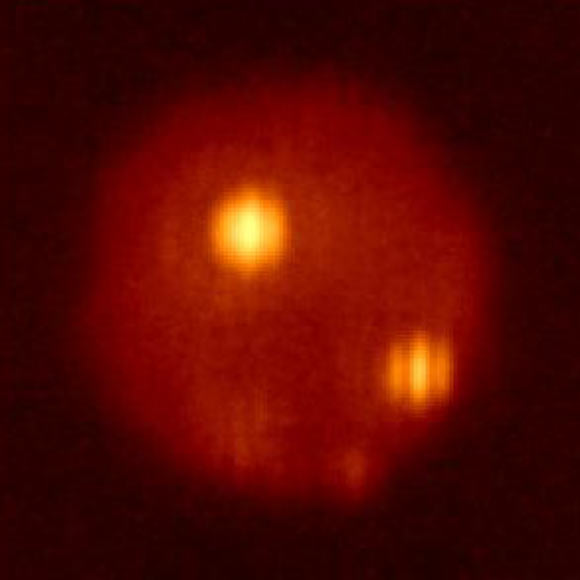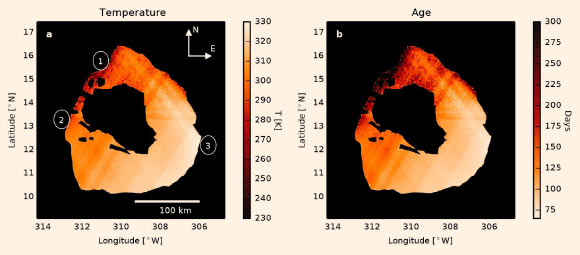Taking advantage of a rare orbital alignment between Jupiter’s moons Io and Europa, a research team led by scientists at the University of California at Berkeley has obtained a detailed map of Io’s Loki Patera.

This global view of Io was obtained by NASA’s Galileo spacecraft on 19 September 1997 at a range of more than 500,000 km (310,000 miles). In this image, deposits of sulfur dioxide frost appear in white and grey hues while yellowish and brownish hues are probably due to other sulfurous materials. Bright red materials and ‘black’ spots with low brightness mark areas of recent volcanic activity and are usually associated with high temperatures and surface changes. Image credit: NASA / JPL / University of Arizona.
On March 8, 2015, Europa passed in front of Io, gradually blocking out light from the volcanic moon.
Because Europa’s surface is coated in water ice, it reflects very little sunlight at infrared wavelengths, allowing astronomers to accurately isolate the heat emanating from volcanoes on Io’s surface.
The infrared data showed that the surface temperature of Io’s massive molten lake steadily increased from one end to the other, suggesting that the lava had overturned in two waves that each swept from west to east at about 3,300 feet (1 km) per day.
Overturning lava is a popular explanation for the periodic brightening and dimming of the hot spot, known as Loki Patera.
The most active volcanic site on Io, Loki Patera is about 127 miles (200 km) across.
Astronomers first noticed Io’s changing brightness in the 1970s, but only when NASA’s Voyager 1 and 2 spacecraft flew by in 1979 did it become clear that this was because of volcanic eruptions on the surface.
Despite highly detailed images from NASA’s Galileo mission in the late 1990s and early 2000s, researchers continue to debate whether the brightenings at Loki Patera — which occur every 400 to 600 days — are due to overturning lava in a massive lave lake, or periodic eruptions that spread lava flows over a large area.
“If Loki Patera is a sea of lava, it encompasses an area more than a million times that of a typical lava lake on Earth. In this scenario, portions of cool crust sink, exposing the incandescent magma underneath and causing a brightening in the infrared,” said lead author Katherine de Kleer, a graduate student at the University of California at Berkeley.
“This is the first useful map of the entire patera. It shows not one but two resurfacing waves sweeping around the patera. This is much more complex than what was previously thought,” said co-author Dr. Ashley Davies, of NASA’s Jet Propulsion Laboratory.
“This is a step forward in trying to understand volcanism on Io, which we have been observing for more than 15 years, and in particular the volcanic activity at Loki Patera,” added Imke de Pater, a professor of astronomy at the University of California at Berkeley.

This LBTO image shows Io. Loki Patera is the bright hot spot in the upper part of the disk. Image credit: Large Binocular Telescope Observatory.
To capture images of Io, the team used by the twin 27.6-feet (8.4 m) mirrors of the Large Binocular Telescope Observatory (LBTO).
“Two years earlier, the LBTO had provided the first ground-based images of two separate hot spots within Loki Patera, thanks to the unique resolution offered by the interferometric use of LBT. This time, however, the exquisite resolution was achieved thanks to the observation of Loki Patera at the time of an occultation by Europa,” said co-author Dr. Christian Veillet, LBTO director.
Europa took about 10 seconds to completely cover Loki Patera.
“There was so much infrared light available that we could slice the observations into one-eighth-second intervals during which the edge of Europa advanced only a few miles across Io’s surface,” said co-author Dr. Michael Skrutskie, of the University of Virginia.
“Loki was covered from one direction but revealed from another, just the arrangement needed to make a real map of the distribution of warm surface within the patera.”
These observations gave the astronomers a 2D thermal map of Loki Patera with a resolution better than 6.25 miles (10 km), 10 times better than normally possible with the LBT Interferometer at this wavelength (4.5 microns).
The temperature map revealed a smooth temperature variation across the surface of the lake, from about 270 Kelvin at the western end, where the overturning appeared to have started, to 330 Kelvin at the southeastern end, where the overturned lava was freshest and hottest.

Maps of the temperature and lava crust age within Loki Patera, derived from the LBTO observations. The higher temperatures in the southeast (location 3) indicate that new magma was exposed most recently in this location. Image credit: Large Binocular Telescope Observatory.
Using information on the temperature and cooling rate of magma derived from studies of volcanoes on Earth, de Kleer was able to calculate how recently new magma had been exposed at the surface.
The results — between 180 and 230 days before the observations at the western end and 75 days before at the eastern — agree with earlier data on the speed and timing of the overturn.
Interestingly, the overturning started at different times on two sides of a cool island in the center of the lake that has been there ever since Voyager photographed it in 1979.
“The velocity of overturn is also different on the two sides of the island, which may have something to do with the composition of the magma or the amount of dissolved gas in bubbles in the magma,” de Kleer said.
“There must be differences in the magma supply to the two halves of the patera, and whatever is triggering the start of overturn manages to trigger both halves at nearly the same time but not exactly. These results give us a glimpse into the complex plumbing system under Loki Patera.”
Lava lakes like Loki Patera overturn because the cooling surface crust slowly thickens until it becomes denser than the underlying magma and sinks, pulling nearby crust with it in a wave that propagates across the surface.
“As the crust breaks apart, magma may spurt up as fire fountains, akin to what has been seen in lava lakes on Earth, but on a smaller scale,” Prof. de Pater said.
The researchers are eager to observe other Io occultations to verify their findings, but they’ll have to wait until the next alignment in 2021.
The results were published in the May 11, 2017 issue of the journal Nature.
_____
K. de Kleer et al. 2017. Multi-phase volcanic resurfacing at Loki Patera on Io. Nature 545: 199-202; doi: 10.1038/nature22339
This article is based on text provided by the University of California at Berkeley.







